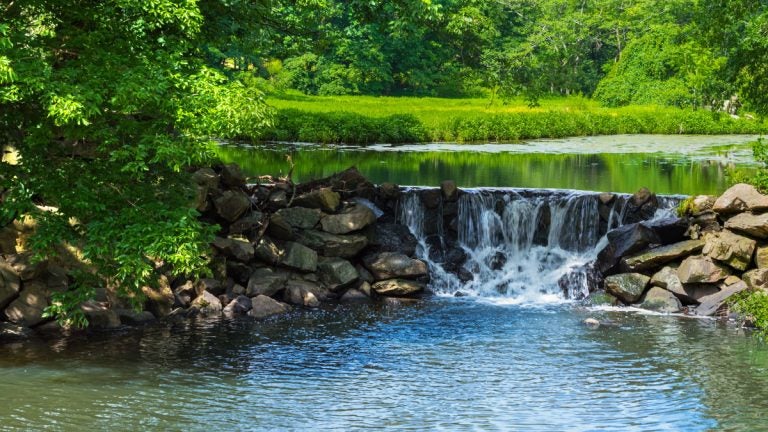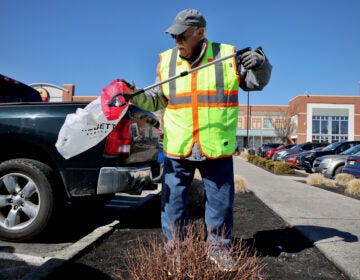Climate change could threaten our drinking water

A small quiet waterfall in Duke Farms in Central New Jersey. (Big Stock photo)
 Clean, plentiful drinking water is critical for New Jersey’s families, businesses, and the future health and wellbeing of our state. In addition to the challenges that water-supply regulators and utilities have faced in the past, a new two-volume report released by the New Jersey Climate Adaptation Alliance brings attention to the challenges a changing climate poses to our drinking-water supplies. The reports also offer insights on strategies that New Jersey can adopt to increase the resilience of our water supplies and the systems that deliver water to our residents.
Clean, plentiful drinking water is critical for New Jersey’s families, businesses, and the future health and wellbeing of our state. In addition to the challenges that water-supply regulators and utilities have faced in the past, a new two-volume report released by the New Jersey Climate Adaptation Alliance brings attention to the challenges a changing climate poses to our drinking-water supplies. The reports also offer insights on strategies that New Jersey can adopt to increase the resilience of our water supplies and the systems that deliver water to our residents.
Future climate change impacts could result in various scenarios that threaten our water supply in different ways. In our region, climate change is predicted to cause variations in temperature, precipitation patterns, sea level, and the frequency and intensity of extreme weather events. Increased drought could reduce the availability of water for residents and industry while decreasing the quality of water in our streams. Precipitation is expected to come in less frequent, more intense, events, potentially increasing flooding and introducing more pollutants and pathogens into waterways. Rising sea levels could cause salt water contamination of coastal aquifers. Flooding, sea-level rise, and more major storms could endanger important water-delivery infrastructure.
The new report finds that, in order to ensure the integrity of our water supply, New Jersey must stop relying on historic trends about factors such as precipitation and temperature for water-supply planning and, instead, integrate projections of changing climate and environmental conditions using the latest science. In order to truly protect our water supply for current and future generations, we need to begin evaluating the risks that changing climate conditions pose to our water supply and move forward with adaptation measures from the state to the local level.
Important steps we can take now include updating standards for utilities to track water losses in their systems and reduce leakages, continuing to adopt the latest construction code standards to promote water efficiency in homes and businesses, and promoting low-irrigation landscapes and widespread use of rain sensors and other technologies that reduce lawn water use. An ounce of prevention is worth a pound of cure; taking actions now to adapt and prepare our water supply for changing climate conditions not only protects our water supply for future generations, it can potentially reduce costs in the long run.
The two-volume report, Climate Change Adaptation in the Water Supply Sector, identifies potential vulnerabilities in our state’s water-supply system, advocates for a scenario-based planning approach to prepare for a wide range of future conditions, and recommends actions that can be taken now to better prepare for future conditions. Ranging from conservation measures to protecting the sources of our drinking water, improved planning for physical projects, adaptation to protect water supply will require coordination across many agencies and entities at all levels of government. The report makes clear that with leadership, resources, and collaboration among varying levels of government and the private sector, we can start acting now to safeguard our water supply and offers important guidance to achieve those goals.
Ensuring adequate supply with conservation and efficiency
Increasing our resiliency during hot summers and drought conditions is critical for the future and can be achieved through utility water-conservation programs, consumer water efficiency measures, and reuse of stormwater and wastewater. During high temperatures, water use increases in both the residential sector, to water lawns and fill pools, and the commercial sector for cooling systems. New Jersey’s water supplies are already stressed during the summer months and implementing conservation and efficiency programs will not only combat climate change vulnerabilities, but also improve the overall capacity of our water supply. Important steps we can take now include updating the standards for utilities to track water losses in their systems and reduce leakages, continuing to adopt the latest construction-code standards to promote water efficiency in homes and businesses, and promoting low-irrigation landscapes and widespread use of rain sensors and other technologies that reduce lawn water use.
New Jersey can also achieve significant water savings through water reuse. Currently, 80 percent of wastewater is only used once before being discharged into the ocean. This water could instead be used on a large scale to reduce water consumption at industrial facilities and power plants or it could be reused within an individual building for purposes such as flushing toilets. This water source also has the potential to help protect our coastal aquifers from salt water contamination; injected underground it can serve as a buffer to keep the saline water away from fresh-water supplies.
Protecting water quality at the source and downstream
Climate change has the potential to threaten water quality in two ways: (1) precipitation will come in fewer, more intense storms that could mean more pollutants entering waterways, and (2) high temperatures and reduced stream flows during most periods mean concentrations of pollutants in our waterways are not diluted. Tackling this challenge now at our drinking-water sources will help avoid additional treatment costs in the long run. Protecting water quality will require collaboration at all levels of government and among water utilities to reduce stormwater runoff and inappropriate development in floodplains. The Legislature can also require utilities to develop source water protection programs for their aquifers and watersheds and invest in mitigating climate-induced damages to their supplies.
Commitment to funding
While state and federal money is available for utility capital projects, and we need utilities to act to improve infrastructure and reduce vulnerability, more funding is needed to protect the sources of our drinking water and implement conservation and efficiency measures. We must identify and fund the most cost-effective programs to address risks and vulnerabilities presented as the result of changing climate conditions.
This funding is especially important as climate-change adaptation can also help us address other challenges facing our water supply, such as increasing population, increasing outdoor water uses in summer, increasing pollution entering waterways, and the aging of our water-supply systems.
To combat the impacts of climate change on water supply, New Jersey needs to identify future risks, collaborate and develop an adaptation strategy, and provide funding to implement that strategy. Revision of the Statewide Water Supply Plan, last adopted in 1996, is a tremendous opportunity to integrate science-based projections about changing climate conditions and strategies to prepare for and adapt to those conditions. Acting now, we still have time and a variety of adaptation strategies can be pursued. Water is essential to New Jersey’s health and economy; delaying climate adaptation measures for our water supply is not a risk we can take.
Former Gov. Tom Kean Sr. served as New Jersey’s Republican chief executive from 1982 to 1990 and was chairman of the 9/11 Commission.
Former Gov. Jim Florio, a Democrat, led the state from 1990 to 1994. He also served as a member of the U.S. House of Representatives for 15 years between 1975 and 1990.
__________________________________________________
NJ Spotlight, an independent online news service on issues critical to New Jersey, makes its in-depth reporting available to NewsWorks.
WHYY is your source for fact-based, in-depth journalism and information. As a nonprofit organization, we rely on financial support from readers like you. Please give today.




